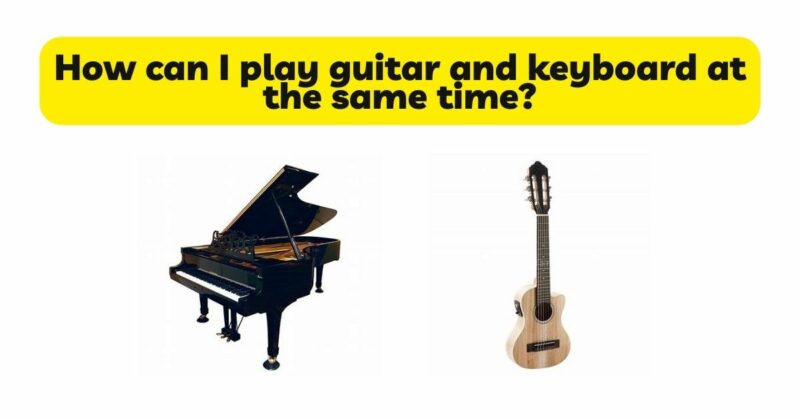Combining the melodic richness of the guitar with the harmonic depth of the keyboard creates a dynamic and captivating musical experience. Playing guitar and keyboard simultaneously is a challenging yet rewarding endeavor that allows musicians to explore new realms of creativity and expand their musical horizons. In this article, we will delve into the techniques, considerations, and strategies for mastering the art of playing guitar and keyboard at the same time. By understanding the technical aspects, hand coordination, instrument integration, and creative possibilities, musicians can unlock the potential of this unique musical fusion.
- Understand the Technical Aspects: Before embarking on the journey of playing guitar and keyboard simultaneously, it is essential to have a solid understanding of the technical aspects of both instruments. Familiarize yourself with guitar playing techniques such as chords, strumming, fingerpicking, and fretboard navigation. Similarly, develop a strong foundation in keyboard playing, including scales, chords, hand positions, and playing dynamics. Mastery of the technical aspects of each instrument independently lays the groundwork for combining them harmoniously.
- Develop Hand Independence and Coordination: Playing guitar and keyboard simultaneously demands exceptional hand independence and coordination. Each hand must perform distinct musical parts, such as playing chords on the guitar while performing melodies or harmonies on the keyboard. Practicing exercises that focus on developing hand independence and coordination is crucial. Start by isolating each hand’s movements and gradually integrate them together, gradually increasing the complexity of the musical parts.
- Determine the Role of Each Instrument: To effectively play guitar and keyboard together, it is essential to determine the role each instrument will play in the overall musical arrangement. Consider whether the guitar will provide the rhythmic foundation, strumming chords or playing arpeggios, while the keyboard handles the melody or provides harmonies. Experiment with different combinations to find a balance that complements the overall sound and musical arrangement.
- Integrate Chords, Melodies, and Harmonies: The integration of chords, melodies, and harmonies is a critical aspect of playing guitar and keyboard simultaneously. The guitar can provide the rhythmic foundation with strummed or fingerpicked chords while the keyboard plays melodic lines or harmonizes with the guitar’s melody. Conversely, the guitar can take on the melodic role while the keyboard fills in the harmonies or plays chord progressions. Strive for a seamless integration where the chords, melodies, and harmonies of both instruments complement and enhance each other.
- Utilize Capo and Transposition: Using a capo on the guitar or transposing chords can help achieve a better integration between the guitar and keyboard. By changing the key of the guitar chords, you can align them with the keyboard’s tonality, making it easier to play both instruments simultaneously. Experiment with different capo positions or transposition techniques to find the best key that allows for comfortable playing on both guitar and keyboard.
- Adapt Techniques for Each Instrument: Adapting playing techniques for both guitar and keyboard is crucial when combining them. Guitarists may need to modify their strumming technique to accommodate the keyboard playing. Consider using fingerpicking or arpeggiated patterns on the guitar to create a rhythmic foundation while allowing more freedom for the keyboard hand. On the keyboard, focus on maintaining smooth hand movements and adapting fingering techniques to optimize hand coordination while simultaneously playing guitar.
- Coordination of Timing and Rhythm: Achieving coordination in timing and rhythm is essential when playing guitar and keyboard simultaneously. Both instruments must align rhythmically to create a cohesive and synchronized sound. Develop a strong sense of internal rhythm and practice with a metronome to solidify your timing. Pay attention to rhythmic subdivisions, syncopation, and maintaining a steady tempo. By honing your timing and rhythm skills, you can create a seamless and tight integration between the guitar and keyboard.
- Explore Creative Possibilities: Playing guitar and keyboard simultaneously offers a world of creative possibilities. Experiment with different musical styles, genres, and textures. Utilize the guitar’s versatility to create rhythmic patterns, chord progressions, or melodic lines while the keyboard adds harmonic depth and melodic embellishments. Embrace the freedom to explore improvisation and spontaneous musical interactions between the guitar and keyboard. Allow yourself to create unique musical arrangements that showcase the best of both instruments.
Conclusion: Playing guitar and keyboard simultaneously requires dedication, practice, and a deep understanding of both instruments. By understanding the technical aspects, developing hand independence, determining the roles of each instrument, integrating chords and melodies, and coordinating timing and rhythm, musicians can achieve a harmonious fusion of guitar and keyboard. Embrace the creative possibilities, explore different musical styles, and adapt playing techniques to suit both instruments. With time, patience, and a passion for music, you can master the art of playing guitar and keyboard at the same time, creating a dynamic and captivating musical experience that showcases the unique qualities of both instruments.


